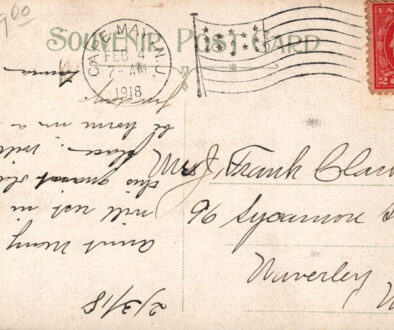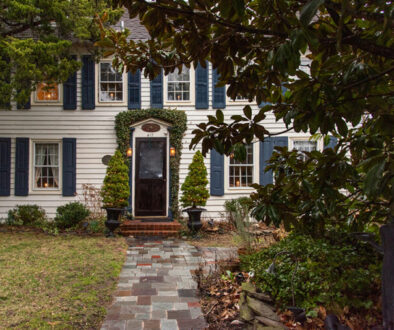Chasing the Blues: Up Close and Personal with the Eastern Bluebird
Winter is over, thank goodness, and prospective Eastern Bluebird parents are building fresh nests or restoring last year’s residences to shelter the several broods of babies they will produce through the summer. It’s time for New Jersey Bluebird Society monitors to begin checking bluebird nesting boxes installed in fields and backyards throughout the state.
Three bluebird species live in the United States: Mountain, Western, and our own Eastern, found from Michigan eastward. They are not blue all over; the chest is rusty red, much the same color as a robin’s. But this bird is smaller and, as we infer from its name, blue over the rest of the body. The male is bright blue; the female not so much—she has a grayish faded-blue back, head, and tail, with a duller red chest.
Ellen Seward is ready and already working on her regular monitoring routine. She has been living with bluebirds since 2011, when she seduced them onto the deck where she lived in Williamstown, New Jersey. “I put a box on my deck, about 10 feet above the base of the deck, and they came! About 10 feet from my sliding glass door.”



She observed them, even watched them have babies, then added a feeding box, enabling the birds to safely find food protected from pesky interference from other birds, and most important, from predators.
A few years later she read a newspaper article about Allen Jackson, who was the New Jersey Bluebird Society’s Cumberland County Coordinator and helped organize the state chapter of the society. There, Ellen learned about the society’s statewide monitoring project. Jackson visited Ellen’s bluebird box and approved it, allowing her to continue observing and learning. She and her husband, Tom Poussart, added a specially designed feeding boxwith transparent walls so they could see that the bluebirds “are smart enough to go in and out to feed.”
Here’s how smart they are.
A storm blew the nesting box off its post and onto the top of the deck railing. Ellen secured it there with some bricks, and went off to her nursing job, her good conscience overcoming her preference to stay home all day to see how the birds would react. When she came home, the resident birds had found the box, caring not a chit that it was lower to the ground than they prefer, remaining faithful to the home they had built rather than roving around to find a new one. “They were bending over, looking inside the hole, wondering, ‘Is this my box?’ and there’s the female craning her neck and looking in there [thinking} it looks like her box, and looking up to see where their box had been.”
Tom returned the box to its higher post and normal life continued.
Ellen and Tom moved to Cape May County in 2016. During one of her regular walks around Cox Hall Creek Wildlife Management Area, Ellen met a woman who was looking at bluebirds through binoculars. Ellen said to her, “Oh, I love bluebirds; I used to take care of them.” The woman told her that the Cape May County Bluebird Society was looking for a monitor and gave her Gail Fisher’sname. Fisher at that time was Cape May County Coordinator for the New Jersey Bluebird Society. Ellen called, Gail came to visit Ellen’s backyard installation, approved it, and just that easily Ellen became a monitor for her new hometown.

Because Cox Hall, a former golf course, was reverting to its wild natural woodsy habitat, the 13-box bluebird community was moving out. Bluebirds prefer open country with trees about 50 feet away that provide shelter and perches that help their babies learn to fly. So they reside in fields like that on the Cape May County Department of Mosquito Control property on Route 47, where Ellen monitors. Fields like this provide bluebirds with the room they need and plenty of the insects that are their main diet: caterpillars, beetles, crickets, grasshoppers, and spiders. In winter, they find fruit from native and local trees and shrubs: sumac, blueberries, black cherry, wild holly, dogwood, hackberries, honeysuckle, and juniper.
“I took the job and schlepped through the weeds twice a week all summer,” Ellen recalls. Allen Jackson and Gail Fisher would join her to move the boxes, if necessary. But Ellen, like other monitors, checks inside the boxes for eggs or newborns, and attaches guards on the posts to prevent predators like the black snake who ate seven chickadee babies—or the one Mosquito Commissioner Dr. Peter Bozak found hanging halfway out of a box on his office porch one morning.
Several other monitors keep track of bluebird boxes throughout the county. They report regularly to the coordinator, now Rae Griffiths. “I heard Gail speak about bluebirds at the Wetlands Institute,”Rae recalls. Rae asked Gail to assess her backyard for bluebird habitat, which proved to be excellent. “I told her about my work in science and bird work in Massachusetts. She looked at me with these bright eyes and said, ‘You’d be perfect to be my successor!’” Gail Fisher was planning to move, so Rae shadowed her all that summer and took over at the end of the season of 2020. Yes, it was the time of Covid, but they were outdoors and able to work safely.
“Gail had personal boxes,” Rae recalls. “She put up a box in my yard, [in Upper Township] so I had a personal box that I was monitoring as well as several others in partnership with other organizations and properties like farms, so I inherited those.” Rae is responsible for about 35 boxes in the county.
Once the monitors find eggs or newborns in a nest, they report that to Rae Griffiths. Then together they fix the time to band the babies. “We determine a good time, we meet, and we band, and then the monitors watch for fledging. [When the brood has flown] they clean things out, and it starts all over again.” Rae is the only strictly bluebird bander in the county; monitors just watch and report and watch some more.
Tom Berger has been watching nest boxes at Amanda’s Field and a private property in Petersburg, as well as two boxes on his own land—where so far only tree swallows have settled. He is a member of the Green Team of Upper Township, a division of the environmental group Sustainable Jersey. At a Green Team meeting about five years ago, Gail Fisher appealed for boxes and monitors in the township. “Everyone was looking at me,” Tom relates. “They said, “You exercise at Amanda’s Field, so how about you do it?” So, for four or five days a week from April through July, he opens box doors and looks in. “Are there eggs or are there not?” Finally, he’ll see two eggs; in a couple more days, maybe two more, up to five or six. “I’ll notify Rae, then she starts a countdown from the time they hatch, makes an appointment [with me]. Then she bands, I assist.”
Three boxes at the rear of Amanda’s field have produced 90% of the birds each year, he notes, each with three broods of five or six babies a season.
Egg incubating period is about 14 days. Monitors try their best to determine hatch day and then count eight or nine days after that, sending photos to Rae so she can help judge. If the babies have grown past 12 days, it’s probably too late. If they’re too tiny the banding will wait. If their eyes are open, which happens at six or seven days, and the pin feathers are growing, it’s time.
Sometimes the parents make that decision. If they’re dive bombing, never mind; they have probably seen an abundance of predators. Rae once spooked a snake lurking nearby when parents were especially noisy. Or there could be house sparrows (“invasive and aggressive”), feral cats; even agile racoons that might climb a post and figure out how to open the box!
On a spring day last year, I followed Ellen and Tom to the field at the Mosquito Control headquarters, where we met Rae. We traipsed through the lumpy grassland to where nest boxes were mounted on a couple of posts in the middle of the field. Rae opened a box and reached in, barehanded, to remove two little bluebird babies. She knew their age, and so did Ellen, just by looking. She placed the babies in my cupped hands, where they settled in, possibly a little confused, but not annoyed.
Rae lifted a tiny little leg, thin as a clover stem, clamped a band around it, repeated the operation for each baby, then returned them to safety. There were five in this box; bluebirds will lay as many as seven in each brood.
All this while, from the time we entered the field, both bluebird parents were perched on power lines directly above us, motionless, watching every move we made. As soon as we walked away, the parents dove down to the box.
(During a later visit to another box, the babies were definitely annoyed; they wiggled and scratched so vigorously that Rae took them back, quickly banded them, and tucked them into safety.)
Monitors continue watching the boxes as the babies grow. “It’s so nice to watch them get bigger and bigger, and then you can’t open the door when they get to be a certain age after, like day ten,” says Ellen. Banding must take place between days eight to 10. Too late and the babies will try to fledge from the bander’s hand, but they are too young to survive on their own.
Is banding a reliable way to learn about bluebirds—where they go, how far they fly? Ellen isn’t sure. It’s rare to find a banded bird; it would be difficult to capture, and the information on the band is hard to read. But, she says, people can be educated by watching the process, much like the public Monarch butterfly bandings in the fall. She foresees the day when GPS chips might replace banding so birds will be easier to track.
Rae Griffiths sees it more broadly, acknowledging that some people object to interfering with the birds’ lives. But she sees the advantage. Even if a recovered bird is dead, “we get some valuable information from that band. You can learn things about lifespan and dispersal” and more. She points out that there are so many bird study projects in Cape May County that it’s possible that a banded bird might be recovered as part of another study.
Some bluebirds migrate, coming here from northern, colder habitats for the winter, but some are natives or at least permanent residents. They will travel as wide as a 50-mile radius if they are searching for new quarters. Or they might spend winter in another box. Bluebirds no longer nest permanently at Cox Hall, but they might spend winters there, roosting in their former homes. Bluebird monitors tape up cracks and spaces to keep out wind and chill and add dry pine needles to insulate nest materials. Unless it’s extremely cold, the adults will survive, sometimes huddled in small groups, fattening up for the rigors of birth and child rearing when they move to the open to start their families.
According to AllAboutBirds.org, “After a male Eastern Bluebird has attracted a female to his nest site (by carrying material in and out of the hole, perching, and fluttering his wings), the female does all the nest building. She makes the nest by loosely weaving together grasses and pine needles, then lining it with fine grasses and occasionally horsehair or turkey feathers.” The pair might remain there together for several seasons.
Bluebirds like cavities; they will select former woodpecker holes in dead pine or oak trees, up to 50 feet off the ground, but older bluebirds are more likely than younger ones to choose a snugger nest box. In the early 20th century, their numbers were endangered by habitat destruction, aggressive introduced species such as European Starlings and the mean, even murderous House Sparrow. In the 1960s and 1970s, concerned naturalists set up bluebird trails and other projects and campaigned to raise awareness of the birds’ dangers. They designed bluebird boxes with holes small enough to keep out the larger predators.
Eastern Bluebirds are no longer considered threatened. Look around. They are everywhere: flying up there right now or poking around open ground seeking nice fresh insects, perched watchfully on power lines or the tops of trees. Their “song” is a rapid chitter.
You can host bluebirds if you have a wide-open area on your property, with trees or shrubs nearby—but not too close! Bluebird boxes are available to buy. Go to the bluebird society website to find sources, or instructions on how to build your own. Or find Rae Griffiths so she can assess your yard and set up the equipment. Place the box on a high metal fence or even better a 3/4-inch metal pole, which will deter predators. Place the box so the opening faces east—this shelters the family from our prevailing westerly winter winds. Buy live mealworms—online, a medium pack of 500 costs about $10. Keep them in your refrigerator (Oh, sure you can! Just don’t tell other members of your household.) so they are dormant, and place portions on the box roof. Then watch for new neighbors to move in.




